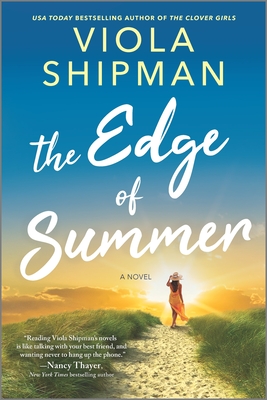 The Edge of Summer by Viola Shipman
The Edge of Summer by Viola Shipman Format: eARC
Source: supplied by publisher via Edelweiss
Formats available: hardcover, paperback, ebook, audiobook
Genres: contemporary romance, relationship fiction, women's fiction
Pages: 400
Published by Graydon House on July 12, 2022
Purchasing Info: Author's Website, Publisher's Website, Amazon, Barnes & Noble, Kobo, Bookshop.org, Better World Books
Goodreads
Bestselling author Viola Shipman delights with this captivating summertime escape set along the sparkling shores of Lake Michigan, where a woman searches for clues to her secretive mother's past
Devastated by the sudden death of her mother—a quiet, loving and intensely private Southern seamstress called Miss Mabel, who overflowed with pearls of Ozarks wisdom but never spoke of her own family—Sutton Douglas makes the impulsive decision to pack up and head north to the Michigan resort town where she believes she’ll find answers to the lifelong questions she’s had about not only her mother’s past but also her own place in the world.
Recalling Miss Mabel’s sewing notions that were her childhood toys, Sutton buys a collection of buttons at an estate sale from Bonnie Lyons, the imposing matriarch of the lakeside community. Propelled by a handful of trinkets left behind by her mother and glimpses into the history of the magical lakeshore town, Sutton becomes tantalized by the possibility that Bonnie is the grandmother she never knew. But is she? As Sutton cautiously befriends Bonnie and is taken into her confidence, she begins to uncover the secrets about her family that Miss Mabel so carefully hid, and about the role that Sutton herself unwittingly played in it all.
My Review:
When she was a very young woman Mabel Douglas learned a hard lesson that it is dangerous to let people in – because once they are inside your guard they are close enough to administer a fatal blow to your heart if not to your body. So she keeps everyone in the small Ozark town of Nevermore at arm’s length – even her much loved daughter, Sutton.
So it’s fitting, in a terrible and sad way, that “Miss Mabel”, as she is known to her neighbors, dies alone, under quarantine in a nursing home during the early, deadly months of the COVID-19 pandemic, only able to see or be seen by her grief-stricken daughter through a window, the glass all too frequently darkly at best.
Sutton is alone, nearly 40, at best partially employed due to the pandemic, and suddenly aware that the few facts she thought she knew about her mother and her mother’s hidden past were all at best misdirection, and at worst outright lies. That’s one of the few certainties to be gleaned from her mother’s last letter to her, delivered to Sutton by the nursing home in a box of her mother’s effects.
In her mother’s cottage, Sutton has all the things her mother prized most – her vintage Singer sewing machine – known fondly as “Ol Betsy”, her few hidden keepsakes, and her vast collection of vintage buttons. Along with just a few hints to their real origins – a story that Mabel refused to tell her daughter in life and barely left a hint of after her death.
But once Sutton emerges from the depths of her grief, and the world emerges from quarantines and lockdowns, Sutton discovers that she doesn’t want to return to her job as a principal buyer and designer at a Chicago-based women’s clothing store chain. What she wants to do is follow those few tiny clues her mother left her, in the hopes of learning, at last, who her mother really was.
And to perhaps discover who Sutton is meant to be after all.
Escape Rating B: I very much liked the parts of The Edge of Summer, but in the end I wasn’t quite sure whether or not it gelled into a whole. I’ll let you be the judge of that.
The story begins during the early days of COVID-19 pandemic. At the point where everything was uncertain, the disease was deadlier than anyone wanted to think about, and the end wasn’t remotely in sight. Which means we meet Sutton at pretty much her lowest ebb. Not just because her mother is dying – although that’s a big part of it – but because she can’t even BE with her mother while she’s passing. Sutton is alone on the outside of the nursing home while her mother is dying alone on the inside of it. Sutton’s life is in chaos and her one anchor in the world is dying – leaving all of Sutton’s questions unanswered and probably unanswerable.
Everyone Sutton knows or meets during this story lost someone to the pandemic. It’s still a very close and real event to people, and the reaction in the story is that a lot of people have drawn closer and become more supportive of each other in the aftermath. I’ll admit that bit felt more hopeful than real, but it was still nice to read. It was, however, heartbreaking but very real that people were impacted and were still being impacted even after the vaccines were available and the quarantines had ended.
Sutton’s sparse clues about her mother’s past lead her to the resort towns on the Lake Michigan shoreline, Saugatuck and Douglas. Douglas was, at least for the purpose of this book, once the pearl button capital of not just Michigan but the entire U.S. That’s where all those tiny clues point, and that’s where Sutton goes to hunt them down.
It’s a past that is elusive in a way that makes it clear that there’s a secret – or two – or ten – buried in the sand dunes near the towns. But as much as the story is about Sutton’s search for her mother’s past it’s also about a search for her own present and future away from her mother’s shadow – even as she learns the reasons why that shadow was so deep and so dark.
So it felt like there were three stories blended into one in The Edge of Summer. One was the bittersweet story of Sutton growing up in a tiny town in the Ozarks with her mother Mabel. It was a childhood filled with love and lies, where Mabel and Sutton were all in all to each other – if only because Mabel refused to let anyone else into their tiny world and taught Sutton to do the same.
The second story was Sutton’s quest to discover the truth about her mother’s past, and the real reason she ended up in Nevermore all alone with a baby seemingly before she turned 20. The past that Sutton searches for is still there to find, a snake lying in the grass ready to bite and poison her just as it did her mother all those years ago.
For this reader, that story had a bit of villain fail. There’s no question her mother’s reasons for leaving were real and valid and necessary, where I thought it fell down a bit was in the villain’s perspective. We know what happened but not really why it happened. Villains are never the villains of their own stories and I felt like I missed someone’s justification for their actions, however twisted it might have been.
The third story, of course, was Sutton’s search for a life no longer bounded by all the self-protective and isolating lessons that her mother taught her. Those are the kind of lessons that are most difficult to unlearn, because they were taught with love and were meant for the best. But Sutton is rightfully tired of being alone and she needs to let some of those lessons go in order to reach out to others. That she finds love as part of her journey is expected and even welcome, but I didn’t get quite enough of the romance to buy into this particular part of her HEA.
All in all, three lovely stories that didn’t quite gel into one whole, at least not for this reader. But a heartwarming time was still had by all, so I’ll be back during the holidays for the author’s next book, A Wish for Winter, which sounds like it might be a bit of a follow-up to this charming story.
Reviewer’s Notes: Two final notes before this review is closed. First, I had a surprising amount of fun jumping down rabbit holes trying to guess which dying Chicago department store Sutton was working for when the story begins. The trip down memory lane took me back to Marshall Field’s, Carson, Pirie, Scott and even Lytton’s in an attempt to narrow it down. I’m probably not even close but I had a grand time looking. Second, I never expected to find another reference to “crown shyness” in a book any time soon after A Prayer for the Crown Shy. I was wrong because it’s in The Edge of Summer as well. It’s turning out to be a surprisingly useful metaphor and I wouldn’t be surprised at all to see it turn up again!


















